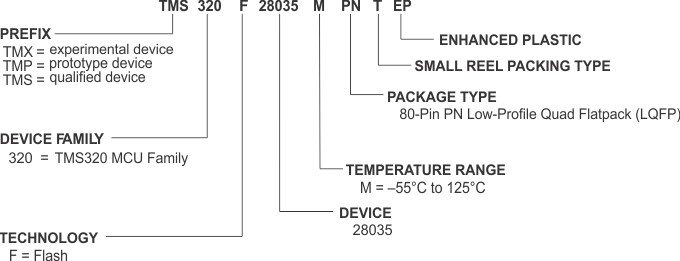ZHCSIE4A June 2018 – July 2018 TMS320F28035-EP
PRODUCTION DATA.
- 1器件概述
- 2修订历史记录
- 3Terminal Configuration and Functions
-
4Specifications
- 4.1 Absolute Maximum Ratings
- 4.2 ESD Ratings
- 4.3 Power-On Hours (POH) Limits
- 4.4 Recommended Operating Conditions
- 4.5 Power Consumption Summary
- 4.6 Electrical Characteristics
- 4.7 Thermal Resistance Characteristics
- 4.8 Thermal Design Considerations
- 4.9 Emulator Connection Without Signal Buffering for the MCU
- 4.10 Parameter Information
- 4.11 Test Load Circuit
- 4.12 Power Sequencing
- 4.13 Clock Specifications
- 4.14 Flash Timing
-
5Detailed Description
- 5.1
Overview
- 5.1.1 CPU
- 5.1.2 Control Law Accelerator (CLA)
- 5.1.3 Memory Bus (Harvard Bus Architecture)
- 5.1.4 Peripheral Bus
- 5.1.5 Real-Time JTAG and Analysis
- 5.1.6 Flash
- 5.1.7 M0, M1 SARAMs
- 5.1.8 L0 SARAM, and L1, L2, and L3 DPSARAMs
- 5.1.9 Boot ROM
- 5.1.10 Security
- 5.1.11 Peripheral Interrupt Expansion (PIE) Block
- 5.1.12 External Interrupts (XINT1–XINT3)
- 5.1.13 Internal Zero Pin Oscillators, Oscillator, and PLL
- 5.1.14 Watchdog
- 5.1.15 Peripheral Clocking
- 5.1.16 Low-power Modes
- 5.1.17 Peripheral Frames 0, 1, 2, 3 (PFn)
- 5.1.18 General-Purpose Input/Output (GPIO) Multiplexer
- 5.1.19 32-Bit CPU-Timers (0, 1, 2)
- 5.1.20 Control Peripherals
- 5.1.21 Serial Port Peripherals
- 5.2 Memory Maps
- 5.3 Register Maps
- 5.4 Device Emulation Registers
- 5.5 VREG/BOR/POR
- 5.6 System Control
- 5.7 Low-Power Modes Block
- 5.8 Interrupts
- 5.9
Peripherals
- 5.9.1 Control Law Accelerator (CLA) Overview
- 5.9.2 Analog Block
- 5.9.3 Detailed Descriptions
- 5.9.4 Serial Peripheral Interface (SPI) Module
- 5.9.5 Serial Communications Interface (SCI) Module
- 5.9.6 Local Interconnect Network (LIN)
- 5.9.7 Enhanced Controller Area Network (eCAN) Module
- 5.9.8 Inter-Integrated Circuit (I2C)
- 5.9.9 Enhanced PWM Modules (ePWM1/2/3/4/5/6/7)
- 5.9.10 High-Resolution PWM (HRPWM)
- 5.9.11 Enhanced Capture Module (eCAP1)
- 5.9.12 High-Resolution Capture (HRCAP) Module
- 5.9.13 Enhanced Quadrature Encoder Pulse (eQEP)
- 5.9.14 JTAG Port
- 5.9.15 General-Purpose Input/Output (GPIO) MUX
- 5.1
Overview
- 6Applications, Implementation, and Layout
- 7器件和文档支持
- 8机械、封装和可订购信息
7.2 器件和开发支持工具命名规则
为了标明米6体育平台手机版_好二三四开发周期的阶段,TI 为所有 TMS320™MCU 器件和支持工具的部件号指定前缀。每个 TMS320 MCU 商用系列米6体育平台手机版_好二三四成员均具有以下三个前缀中的一个:TMX、TMP 或者 TMS(例如,TMS320F28032)。米6体育平台手机版_好二三四 (TI) 建议为其支持的工具使用三个可能前缀指示符中的两个:TMDX 和 TMDS。这些前缀代表了米6体育平台手机版_好二三四开发的发展阶段,即从工程原型 (TMX/TMDX) 直到完全合格的生产器件/工具 (TMS/TMDS)。
器件开发进化流程:
| TMX | 试验器件不一定代表最终器件的电气规范标准。 | |
| TMP | 最终的芯片模型符合器件的电气规范标准,但是未经完整的质量和可靠性验证。 | |
| TMS | 完全合格的生产器件 |
支持工具开发发展流程:
| TMDX | 还未经米6体育平台手机版_好二三四 (TI) 完整内部质量测试的开发支持米6体育平台手机版_好二三四 | |
| TMDS | 完全合格的开发支持米6体育平台手机版_好二三四 |
TMX 和 TMP 器件和 TMDX 开发支持工具出货时带有如下的免责声明:
“开发米6体育平台手机版_好二三四用于内部评估用途。”
TMS 器件和 TMDS 开发支持工具已进行完全特性描述,并且器件的质量和可靠性已经完全论证。TI 的标准保修证书适用。
预测显示原型器件(TMX 或者 TMP)的故障率大于标准生产器件。由于它们的预计的最终使用故障率仍未定义,米6体育平台手机版_好二三四建议不要将这些器件用于任何生产系统。只有合格的米6体育平台手机版_好二三四器件将被使用。
TI 器件的命名规则还包括一个带有器件系列名称的后缀。这个后缀包括封装类型(例如,PN)和温度范围(如,T)。Figure 7-1 提供了解读任一系列米6体育平台手机版_好二三四成员完整器件名称的图例。
要获取器件部件号以及更多订购信息,请访问 TI 网站 (www.ti.com) 或者联系您的 TI 销售代表。
有关裸片器件命名规则标记的其他 说明 ,请参阅《TMS320F2803x Piccolo™ MCU 器件勘误表》。
 Figure 7-1 器件命名规则
Figure 7-1 器件命名规则